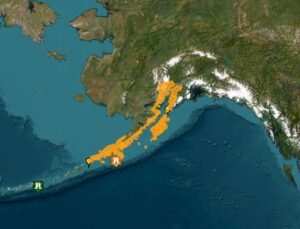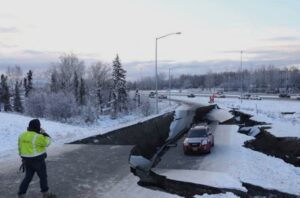Mega Earthquake Hits Alaska: 7.3 Magnitude Jolt Triggers Tsunami Warning, Sparks Widespread Alert
A Mega Earthquake Hits Alaska: A mega 7.3-magnitude earthquake struck off the coast of Alaska on Wednesday. Shaking the remote U.S. state and triggering a tsunami warning that affected vast stretches of the Alaska Peninsula.
The quake, categorized as a major seismic event, was followed by multiple aftershocks, though no large-scale damage or fatalities were reported at the time of writing.
Mega Earthquake Hits Alaska Details: A Sudden Jolt Beneath the Sea
According to the U.S. Geological Survey (USGS), the earthquake occurred at 12:37 PM local time (2037 GMT).
The epicenter was located about 54 miles (87 kilometers) south of Sand Point, near Popof Island, at a depth of approximately 20.1 kilometers.
The Alaska Earthquake Center noted that the tremors were felt across the Alaska Peninsula and southern Alaska, shaking buildings and prompting widespread concern among coastal communities.
🌊 Tsunami Warning Issued after Mega Earthquake Hits Alaska : Urgent Alerts Across Coastal Regions
In the immediate aftermath of the quake, the National Tsunami Warning Center (NTWC) in Palmer issued a tsunami warning for a large part of the Pacific coast of Alaska, including:
- Kennedy Entrance (40 miles southwest of Homer)
- Unimak Pass (80 miles northeast of Unalaska)
The warning covered approximately 700 miles of coastline. The NTWC confirmed that a tsunami had been generated and warned residents of possible dangerous coastal flooding.
Residents in affected areas like Cold Bay, Sand Point, and Kodiak were urged to move inland and to higher ground immediately.
By 1:50 PM, the alert was downgraded to a tsunami advisory, and by 2:43 PM, it was officially canceled after sea-level data confirmed the threat had passed.
NTWC in Latest update said that “A cancellation is issued after an evaluation confirms that a destructive tsunami will not impact the region” .

🔁 Series of Aftershocks Rock Alaska’s Coastline
The USGS reported over 20 aftershocks following the initial quake. Among them was a magnitude 5.2 tremor located 66 miles south-southeast of Sand Point.
At least five aftershocks registered above magnitude 4, adding to the tension for residents already rattled by the main quake.
The Alaska Earthquake Center indicated that further data collection may cause minor revisions to the quake’s magnitude or epicenter location.

🌍 No Threat to Hawaii, Washington, or Other Pacific Regions
Officials in Hawaii and Washington state were quick to assess potential impacts.
The Office of Emergency Management of Hawaii’s O’ahu confirmed there was no tsunami threat to the island.
Likewise, the Washington Emergency Management Division announced there was no danger to its coastline.
Monitoring sensors at DART tsunami buoys showed no significant wave activity to suggest any threat beyond Alaska’s immediate region.
Washington officials informed that “Scientists had to wait to examine wave heights at tsunami buoys — and those sensors now indicate there is NO DANGER for our coastline,” .
🧠 Earthquake Facts: Understanding the Threat Level of Mega Earthquake Hits Alaska
According to the Michigan Technological University, a magnitude 7.0 to 7.9 quake is considered major. And capable of serious damage, especially in populated or structurally weak areas. On average, the world experiences 10 to 15 such quakes per year.
While Wednesday’s 7.3-magnitude event caused concern, Alaska has a long seismic history. It sits on the Pacific Ring of Fire, a zone known for intense tectonic activity.
📜 Historic Context: Alaska’s Seismic Legacy
Alaska has faced powerful quakes in the past. Most notably, in March 1964, a devastating 9.2-magnitude earthquake — the strongest ever recorded in North America — struck the region.
It destroyed parts of Anchorage and triggered a tsunami that hit Hawaii and the U.S. West Coast, killing over 250 people.
More recently, in July 2023, a 7.2-magnitude quake hit off the Alaskan Peninsula, but it caused minimal damage and no tsunami.

Preparedness and Vigilance
While the 7.3-magnitude mega earthquake rattled Alaska, swift action by monitoring agencies helped avert widespread disaster.
The rapid downgrade and eventual cancellation of the tsunami alert showed that preparedness and advanced warning systems remain vital in earthquake-prone regions.
Residents are encouraged to remain alert for future tremors and ensure they follow local emergency guidelines to stay safe in the event of aftershocks or future seismic events.
